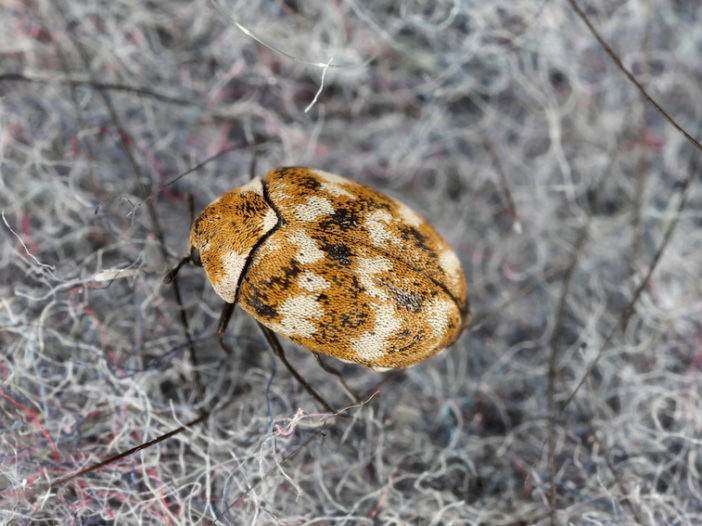
We’ve been there. The temperatures drop and you reach deep into your closet for that cozy wool sweater only to find that something has chewed a hole in it. It could be a clothes moth, but if there’s just one big hole, you can probably blame it on a carpet beetle.
Carpet Beetle Larvae
The true culprit is actually not the carpet beetle, but its larvae that prefer to feed on animal products such as wool, silk, leather, and even hairbrushes. Being fussy things, they don’t feed on synthetic fibers and they prefer to eat in the dark where they will be undisturbed. In other words, the back of a dark closet, or far reaches of an attic, are prime areas for dining.
The dark, mysterious ways of the larvae differ from adult carpet beetles that are attracted to sunlight and are typically found near windows, on sills, or in the curtains. The adults also don’t feed on fabric. They enjoy pollen and nectar meaning they generally don’t find their way inside your home unless they are brought in with that bouquet you picked from your yard or brought home from the farmer’s market. Sometimes they also just get lost and come in from an open window. So just seeing a carpet beetle isn’t cause for alarm. The problem with the adults is strictly that they lay eggs leaving behind their damaging offspring.
Signs of A Carpet Beetle Infestation
The telltale signs that carpet beetle larvae have invaded come from seeing the skin they leave behind when they molt, as well as fecal pellets, and from the larger holes that you find in your clothes, carpets, or any other animal-based products. The skin left behind will be brown, bristly, and shell-like. Because they stay in place to eat, the holes they make are larger and confined, unlike moth holes which are smaller and scattered.
While the carpet beetle is not as common as pesky clothes moths, they are one of the most difficult pests to eradicate. Once inside they can spread anywhere and everywhere, and if they are laying eggs, they’ll be hidden in the dark recesses of your home.
Prevention
The best prevention is regular and deep cleaning of carpets, curtains, and upholstered furniture. Any dead bugs, pet hair, or even human hair can be a buffet. Vacuuming will not only rid your home of food sources, but if eggs have been laid, or if beetles are milling around, they will be sucked up into the vacuum bag which can be safely disposed of.
Clean your clothes before you put them into storage to destroy the insects at any stage and then store them in something like a protective plastic bag or airtight container. When it’s time to bring the clothes back out, inspect them carefully for larvae and be prepared to wash them again if you find signs of an infestation. If you, unfortunately, find an infestation in your favorite down pillow, or antique feather-stuffed chair, it’s time to call in the experts. Northwest Pest is happy to help you save your sweaters and keep your home pest-free.